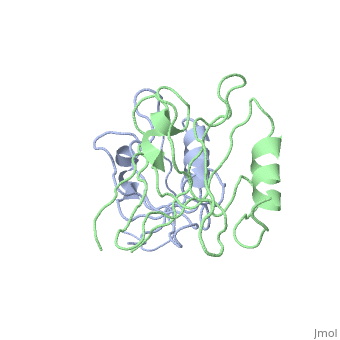1qav: Difference between revisions
No edit summary |
No edit summary |
||
| Line 15: | Line 15: | ||
<text>to colour the structure by Evolutionary Conservation</text> | <text>to colour the structure by Evolutionary Conservation</text> | ||
</jmolCheckbox> | </jmolCheckbox> | ||
</jmol>, as determined by [http://consurfdb.tau.ac.il/ ConSurfDB]. You may read the [[Conservation%2C_Evolutionary|explanation]] of the method and the full data available from [http://bental.tau.ac.il/new_ConSurfDB/ | </jmol>, as determined by [http://consurfdb.tau.ac.il/ ConSurfDB]. You may read the [[Conservation%2C_Evolutionary|explanation]] of the method and the full data available from [http://bental.tau.ac.il/new_ConSurfDB/main_output.php?pdb_ID=1qav ConSurf]. | ||
<div style="clear:both"></div> | <div style="clear:both"></div> | ||
<div style="background-color:#fffaf0;"> | <div style="background-color:#fffaf0;"> | ||
Revision as of 09:57, 9 February 2016
Unexpected Modes of PDZ Domain Scaffolding Revealed by Structure of NNOS-Syntrophin ComplexUnexpected Modes of PDZ Domain Scaffolding Revealed by Structure of NNOS-Syntrophin Complex
Structural highlights
Function[SNTA1_MOUSE] Adapter protein that binds to and probably organizes the subcellular localization of a variety of membrane proteins. May link various receptors to the actin cytoskeleton and the extracellular matrix via the dystrophin glycoprotein complex. Plays an important role in synapse formation and in the organization of UTRN and acetylcholine receptors at the neuromuscular synapse. Binds to phosphatidylinositol 4,5-bisphosphate. [NOS1_RAT] Produces nitric oxide (NO) which is a messenger molecule with diverse functions throughout the body. In the brain and peripheral nervous system, NO displays many properties of a neurotransmitter. Inhibitory transmitter for non-adrenergic and non-cholinergic nerves in the colorectum. Probably has nitrosylase activity and mediates cysteine S-nitrosylation of cytoplasmic target proteins such SRR. Inhibitory transmitter for non-adrenergic and non-cholinergic nerves in the colorectum. Evolutionary Conservation Check, as determined by ConSurfDB. You may read the explanation of the method and the full data available from ConSurf. Publication Abstract from PubMedThe PDZ protein interaction domain of neuronal nitric oxide synthase (nNOS) can heterodimerize with the PDZ domains of postsynaptic density protein 95 and syntrophin through interactions that are not mediated by recognition of a typical carboxyl-terminal motif. The nNOS-syntrophin PDZ complex structure revealed that the domains interact in an unusual linear head-to-tail arrangement. The nNOS PDZ domain has two opposite interaction surfaces-one face has the canonical peptide binding groove, whereas the other has a beta-hairpin "finger." This nNOS beta finger docks in the syntrophin peptide binding groove, mimicking a peptide ligand, except that a sharp beta turn replaces the normally required carboxyl terminus. This structure explains how PDZ domains can participate in diverse interaction modes to assemble protein networks. Unexpected modes of PDZ domain scaffolding revealed by structure of nNOS-syntrophin complex.,Hillier BJ, Christopherson KS, Prehoda KE, Bredt DS, Lim WA Science. 1999 Apr 30;284(5415):812-5. PMID:10221915[1] From MEDLINE®/PubMed®, a database of the U.S. National Library of Medicine. See AlsoReferences |
| ||||||||||||||
